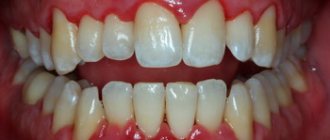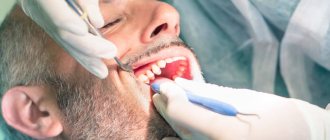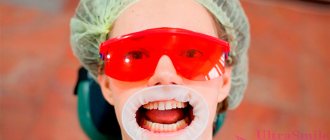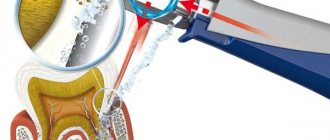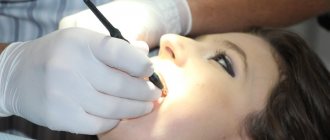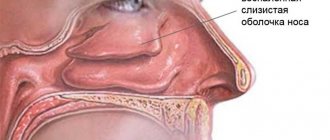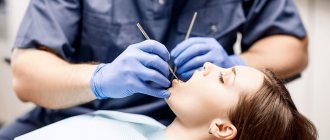Who is recommended for cleaning?
This procedure is recommended for any gum disease. It is usually prescribed when a patient is diagnosed with periodontal disease, periodontitis or gingivitis. Dental manipulation can also be performed if the following symptoms are present:
- Acute reaction to cold or hot.
- Bleeding gums.
- The appearance of “pockets” between the tooth and gum.
- Unpleasant odor from the mouth.
The truth about periodontitis: if you want to keep your teeth and health
The lack of competent information from the patient regarding gum disease and timely professional treatment unfortunately leads to very sad consequences - loss of teeth, and can also threaten a person’s overall health. To prevent them, we talked with the leading periodontist, therapist and surgeon at the Elite Center Clinic, Marina Mikhailovna Shakirova.
Periodontal disease is a disease of the gums and bone surrounding the tooth.
The following stages of gum disease are distinguished:
- Gingivitis is inflammation of the gums caused by plaque.
- Periodontitis is an inflammation of not only the gums, tooth ligament, but also the bone tissue surrounding the tooth.
- Mild periodontitis (I)
- Average degree of periodontitis (II)
- Severe periodontitis (III)
Tab. 1. Signs of the disease
| Gingivitis | I Art. Periodontitis | II Art. Periodontitis | III Art. Periodontitis |
| Blue-red gum color. Swelling and bleeding of the gums when brushing teeth and eating solid foods. Smell from the mouth. Pain (itching, burning) in the gums. | Bleeding gums. The space between the roots of the teeth and the gum (gum pocket). Bad breath. Sore gums. Hypersensitivity of teeth. | ||
| The depth of the gum pockets does not exceed 4-5 mm. | The depth of the gum pockets is 5-6 mm. Exposure of the tooth root. Mobility of teeth. | The depth of the gum pocket is more than 6 mm. Severe tooth mobility and exposed roots. | |
How does the disease occur? After each meal, a small amount of food debris remains on the teeth and between the teeth, which forms a soft plaque. This plaque is difficult to see; oral microorganisms immediately settle in it. Microbes and their metabolic products are deposited on the surface of the tooth and lead to gum inflammation. Gradually accumulating, plaque becomes hard, turning into tartar, which increases inflammation.
So, what every person, especially those suffering from periodontitis, needs to know:
1.100% OF DENTAL CLIENTS HAVE GUM DISEASES.
In 98-100% of patients who come to the clinic with oral problems (caries, etc.), we detect varying degrees of periodontal disease. In addition, 100% of people who smoke suffer from periodontitis!
2.PERIODONTITIS IS A MORE INSANE AND DANGEROUS DISEASE THAN DENTAL CARIES.
There can be no healthy teeth without healthy gums! The teeth may not be affected by caries, but we will lose them because the bone has left the interdental spaces.
3.PERIODONTITIS CAN SIGNAL ABOUT HIDDEN DIABETES!
Of course, the main cause of gum disease is improper and irregular oral hygiene!
BUT! You need to know that PERIODONTITIS is an autoimmune disease (autoimmune diseases are diseases associated with dysfunction of the human immune system, which begins to perceive its own tissues as foreign and damage them).
And diseases such as diabetes mellitus, diseases of the thyroid gland, adrenal glands, systemic osteoporosis, blood diseases, etc. lead to changes in the periodontium. A patient suffering from periodontitis may not even be aware of the hidden course of these diseases.
And for patients with these diseases, it is imperative to see a periodontist.
But! It is useless to treat periodontitis if the patient does not treat the underlying disease (diabetes mellitus, hormonal problems, blood diseases).
4.PERIODONTITIS CAN CAUSE ARTHRITIS, GASTRITIS AND OTHER DISEASES!!!
Periodontal pockets are a source of chronic infection. It has been proven that the long-term presence of infection in the periodontal pocket leads to the development of diseases: rheumatoid arthritis, atherosclerosis, endocarditis, gastritis, etc.
5. PERIODONTITIS MAY NOT MANIFEST FOR LONG YEARS - IT CAN ONLY BE DIAGNOSED BY A DOCTOR!
The insidiousness of the disease is that it does not manifest itself for many years. Only a doctor can make a timely diagnosis and prescribe treatment by examining the oral cavity and x-ray examination (orthopantomogram or computed tomogram (CT)). In addition, we definitely prescribe an additional examination if we see an aggressive course of the disease, exacerbation, mobility, halitosis (bad breath) and, according to X-ray data, significant loss of bone tissue.
A general examination includes blood biochemistry, a complete blood count, an analysis for latent hemoglobin, and the laboratory data obtained very often reveals latent and already progressive forms of diabetes mellitus (in young people). Very often a blood disease is detected.
“REJUVENATION” OF DISEASES – EVEN 16 YEAR OLD PEOPLE ARE SICK.
A feature of the current situation with gum disease is the “rejuvenation” of this process. If earlier this disease was detected after 45-50 years, now we can detect it at 16 and 18. This is usually associated with poor hygiene and crowded teeth. Especially if orthodontic problems are not treated. Moreover, the younger the patient, the more aggressive the course of the disease!
IF A PERSON IS SICK WITH PERIODONTITIS – IT IS FOREVER!
Periodontitis is an autoimmune disease; we can only bring it into remission and prevent further progression. A 100% cure occurs only with gingivitis (if the patient follows the recommendations).
If periodontitis is simply treated once, the effect is lost instantly. Any periodontal disease requires dynamic observation, that is, the so-called dispensary observation, supportive treatment and an invitation to attend MPT (maintenance periodontal treatment). The first examination is after 1 month, the 2nd procedure is after 3 months, then every 4 months. At the Elite Center Clinic, we keep a mandatory journal in which we record the schedule of visits the patient needs and invite him in advance.
GINGIVIT IS 100% ACCOMPANYING PREGNANCY.
Since during pregnancy, hormonal levels change, which leads to changes in the composition of plaque. It is believed that all patients with periodontitis have an increased risk of having a low-birth-weight child, and the source of infection can lead to the early development of caries in babies, and bacteria contained in the discharge from periodontal pockets can provoke miscarriage. This is a proven fact. Therefore, if pregnancy is planned, then it is necessary to undergo treatment by a periodontist and be observed by a periodontist during the 1st and last trimester of pregnancy.
SO HOW TO CORRECTLY TREAT GUM DISEASES?
Traditionally, there are 3 STAGES in periodontal treatment:
STAGE 1 OF TREATMENT:
This is the stage of PROFESSIONAL HYGIENE or otherwise – the closed curettage procedure.
Closed curettage includes:
- professional removal of plaque, tartar (using ultrasound and air-flow)
- root cleaning and polishing.
At the Elite Center Clinic, our patients also have access to the most modern hardware treatment for periodontitis, which often allows us not to proceed to the 2nd stage - surgical treatment:
1) FotoSan device (manufactured by CMS Dental, Denmark) As a result of light photoactivation, oxygen is released, which destroys pathologically altered cells and inflammatory microflora in periodontal pockets. Active oxygen acts instantly, safely, without side effects and eliminates the need for antibiotics.
2) Prozone device (W&H Dentalwerk Burmoos GmbH, Austria) In periodontics, the effectiveness of the Prozone device can hardly be overestimated, because it destroys bacteria in the gingival pocket, which are very difficult to reach, since they are in a biofilm. Bacteria become coked and live there in colonies. With Prozone, ozone penetrates into any place to be disinfected and completely destroys pathogenic microflora, minimizing the risk of re-infection.
3) Vector device (Durr Dental, Germany) The use of ultrasonic energy simultaneously with a jet of highly dispersed suspension of hydroxypatite powder allows you to remove infected granulation tissue, biofilm, plaques, and tartar. At the same time, waste products of microorganisms are washed out. This gives a powerful regenerating impulse and anti-inflammatory effect.
This same stage includes active rinsing with antiseptics and medicinal dressings. With these methods we can stop not only mild, but also moderate periodontitis!
STAGE 2 – SURGICAL TREATMENT
Classical periodontics recommends the use of surgical treatment methods if the pocket is more than 5-6 mm. But how are we doing at the Elite Center Clinic? If the use of all stage 1 treatment methods and laser technologies leads to stabilization, then we do not resort to surgical treatment. That is, if 3 months after the 1st stage of treatment the patient is not exacerbating, then we conduct a course of maintenance periodontal treatment even with a severe form, if it is in a stable phase.
But in any case, severe and aggressive periodontitis requires ONLY COMPREHENSIVE TREATMENT!!! Together with an orthopedist, together with an odontist, together with an endocrinologist, a therapist, a cardiologist.
General somatic diseases are contraindications for surgical treatment.
Before surgery, tooth mobility is prevented - the splinting method is used: we cannot operate on mobile teeth (otherwise they may take the wrong position).
Surgical treatment involves detaching the gum, cleaning the root from subgingival stone, polishing the root, filling this space with a protein-matrix complex or artificial bone, putting the flap back and suturing it. The roots are exposed.
At the Elite Center Clinic, surgical treatment is mandatory with the Emdogain protein-matrix complex.
Emdogain is a drug with a biological composition that promotes predictable restoration of both hard and soft tissues. But! It leads to an increase in bone tissue volume by only 0.5 - 1 mm. The process of bone destruction stops, but new bone does not grow. When applied to the surface of the tooth root, after cleaning it, emdogain begins to imitate biological processes, stimulating the restoration of tissue around the tooth.
Upon completion of the operation, we prescribe dressings, antibiotics, immunocorrective therapy, antihistamines, rinses, and a certain hygienic regimen.
We can carry out all periodontal treatment procedures (quite painful) for our people under sedation and anesthesia!
TAKING SOME DRUGS CAUSE PERIODONTAL DISEASE.
Periodontitis can be detected as a result of taking certain medications, they cause the phenomenon of gum overgrowth. For example: Cyclosparins, drugs that reduce blood clotting, all hormonal drugs. Patients taking hormones should definitely be seen by a periodontist.
Very often we detect periodontitis after suffering severe diseases, for the treatment of which antibiotics were taken. After this, the plaque becomes viscous and easily adheres to the surface of the teeth, which leads to aggravation.
Periodontitis is always present with orthodontic problems.
HYGIENE, HYGIENE AND MORE HYGIENE!!!
The lack of DAILY proper oral hygiene in patients with periodontitis leads to an immediate aggravation - after 12 hours the plaque is fixed and ALL treatment comes to naught.
YOU MUST REMOVE PLATE AND FOOD REMAINS EVERY 12 HOURS!!!
The patient’s task is to come for examinations not in a state of exacerbation, but in a state of remission to a maintenance complex, because each episode of exacerbation leads to loss of bone tissue. We must not allow this to worsen!
During the appointment, we select individually for our patients, based on the indications: what toothpaste should be, what brush, what rinse, in what mode to use, when to replace, what medications to take.
When a patient is sick with acute respiratory infections, acute respiratory viral infections, influenza and other diseases of the upper respiratory tract, the viscosity of saliva increases and local corrective immune factors decrease (their level decreases in the oral cavity). This leads to the fixation of a more sticky plaque. Therefore, after almost all acute respiratory infections and acute respiratory viral infections, we note an exacerbation of processes in patients. During illness, hygiene should be increased. After (during) an illness, you should contact your doctor for corrections in the treatment program (changes in the cleaning regimen are possible, additional antiseptics are prescribed), and additional professional cleaning.
PROSTHETICS AND IMPLANTATION FOR PERIODONTITIS
It is mandatory to undergo periodontal treatment before prosthetics and implantation. Implantation for periodontitis - can be carried out only when periodontitis is in a stable phase; there should be no presence of supra- and subgingival deposits.
BE HEALTHY AND VISIT YOUR DENTIST ON TIME - THIS IS A GUARANTEE OF A HEALTHY AND BEAUTIFUL SMILE!
Sign up online
Registration Online
Execution algorithm
Before you begin cleaning, it is imperative to carry out some diagnostic procedures. Depending on the diagnosis and severity, different procedures may be required:
- Radiography.
- Sanitation of the oral cavity.
- Professional cleaning of units from stone and surface deposits.
The procedure is carried out in two stages, that is, the patient must visit the doctor twice. The algorithm for treating gums through cleaning is individual. Based on your cleaning goals, the steps may vary slightly.
- During the first session, hard formations located in the pockets between the gums and teeth are removed.
- Next, antiseptic treatment is carried out with special medications.
- The dentist applies a therapeutic bandage to the damaged areas of the gums.
- At the second visit, the dentist polishes the teeth and whitens the enamel several shades using an air-abrasive system.
- The final step is to apply fluoride varnish to the surface of the teeth.
After the procedure, a positive effect is observed. Using this procedure, it is possible to remove pathological bacteria, which are often the culprits in the development of oral diseases. After treatment, the likelihood of developing periodontal pathologies is significantly reduced, positive dynamics are clearly observed in existing diseases, and disturbing symptoms disappear.
Indications
Cleaning periodontal pockets provides:
- complete removal of plaque and calculus from tooth enamel (including the surface of the crown in the subgingival part);
- protection against the appearance of cervical caries, carious lesions of the root part of the teeth;
- cessation of inflammatory processes that have already begun;
- slowing down the development of chronic periodontal diseases, prolonged relapse;
- elimination of foci of infection;
- strengthening of gum tissue, under favorable conditions - regeneration of bone tissue, strengthening of teeth.
Without regular professional hygiene, microorganisms accumulate on the surface of the enamel and on the subgingival part of the crown, forming plaque, which later turns into hard deposits (tartar). A layer of tartar separates the gum margin from the crown. The gum tissue is constantly injured, its nutrition is disrupted, and the ligaments supporting the tooth may gradually be destroyed, causing the teeth to become mobile and gradually loosen. The risk of such disorders is especially high for smokers, with poor oral hygiene, and with a predisposition to the occurrence of periodontal diseases. Professional hygiene with cleaning of periodontal pockets reduces it.
Features of periodontal cleaning
Since with gingivitis, periodontal disease or periodontitis, the gums are hyperemic and painful, this manipulation can be performed with anesthesia. In this case, the patient will not experience pain or discomfort.
After cleaning, you must follow some rules to secure the result:
- From the moment the procedure is completed, you need to follow a dietary diet so as not to injure the gums and allow them to “heal” calmly. First of all, it is important to observe the temperature regime; food should be warm; cold and hot foods are prohibited during the week. You should also avoid salty, pickled, spicy, etc.
- The duration of the break between two sessions should not exceed seven days.
- Follow your doctor’s recommendations; depending on the diagnosis, the specialist may prescribe certain medications, rinsing the mouth with special solutions, etc.
- If necessary, a specialist may prescribe painkillers.
- Periodontal cleaning is not suitable for everyone; there is a list of contraindications. These include the period of bearing a child, breastfeeding, open foci of infection in the oral cavity.
Basics of periodontal teeth cleaning
Indications for periodontal teeth cleaning are various moderate and severe periodontal pathologies, such as periodontitis, periodontal disease, gingivitis, as well as structural features of the gingival and bone pockets of the patient’s oral cavity.
Before starting the hygienic procedure, an examination is carried out, a mandatory initial examination is carried out by drawing up a visual orthopantomogram and measuring the depth of the periodontal canals with special probes. In the process of periodontal teeth cleaning, sterile medical instruments, disposable masks, gloves, saliva ejectors and other personal devices are used, due to which the risk of infection of the patient during the procedure is completely eliminated. To eliminate pain, local injection anesthesia is used with modern drugs that provide reliable pain relief without any side effects.
Learn more about the benefits of teeth whitening and teeth cleaning
Results of periodontal treatment
Doctors at a French dental clinic will help you get rid of all the listed symptoms, as well as keep your own teeth in place. The most common periodontal diseases are gingivitis and periodontitis. Periodontitis, for example, if it is severely neglected, can lead to the loss of a tooth or several teeth (and at first they will be very loose).
In very severe (advanced) cases, even intoxication of the body, destruction and degradation of bone tissue are possible. Modern methods of diagnosis, prevention and treatment of periodontal diseases used in our center, as well as a good knowledge of periodontics itself by our dentists, specialists from France, allow us to avoid all of the above dangers.
We promise that periodontal treatment at FDC
it will take a minimum of time, will be carried out completely painlessly and will definitely bring the best result.
Dental hygiene tips from an expert periodontist
The first personal hygiene item is a toothbrush.
My many years of experience show that the brush should be ultra thick and ultra soft. Manufacturers usually label it as ULTRA SOFT.
I RECOMMEND regular hand brushes with silk bristles. My choice was CURAPROX toothbrushes, produced by a Swiss dental company with 75 years of experience and a worldwide reputation - CURADEN. As a worthy replacement, you can use ROCS ultra soft toothbrushes.
I DO NOT RECOMMEND brushes, neither hard nor medium hard, nor with various rubber inserts or with trimmed bristles, nor do I recommend electric brushes. All of them have an aggressive effect on the gums and tooth enamel, damaging them. This leads to numerous problems, such as tooth hypersensitivity, bleeding gums or gum shifting with exposure of the neck of the tooth, etc.
Currently, ultrasonic toothbrushes have appeared. I have nothing against using them. However, I consider the healing properties attributed to them for gums and the ability to eliminate inflammation to be an exaggeration. These brushes are contraindicated for people who suffer from diseases of the cardiovascular system or who have dental implants, dentures or artificial dental crowns.
The second personal hygiene item is toothpaste.
To be used every day, the paste should be preventative. Preventative toothpastes are intended for everyday oral care for preventive and hygienic purposes. In addition to daily care, therapeutic and prophylactic pastes are used for the targeted prevention of dental caries, periodontal diseases, non-carious lesions, and diseases of the oral mucosa.
The second type of toothpaste that you should definitely use is an abrasive toothpaste. All whitening toothpastes and toothpastes for smokers are abrasive. They have good polishing properties. Abrasive substances effectively remove plaque. BUT this type of paste cannot be used every day. It is usually used 2-3 times a week in the morning after breakfast. In order to determine exactly how often you need to use an abrasive toothpaste, all you need to do after brushing your teeth in the morning is to run your tongue along the outer and inner surfaces of all your teeth. If their surface is not smooth, but is rough, it means that your regular toothpaste is not enough and it’s time to brush your teeth again with an abrasive toothpaste. The tongue is the best controller of the condition of your teeth.
The third personal hygiene item is dental floss.
My opinion is that the mentality and culture of a nation in the field of personal hygiene begins with floss. If a person does not know how to use interdental hygiene products, then he will always have dental problems.
Today there are many types of floss. I recommend round shaped waxed reels for regular people. I don’t recommend silk or flat ones, because... they seriously injure the gums. There are also super flosses for patients with implants, braces or other orthodontic structures.
It is extremely difficult to explain in words how to use floss correctly. It's better to see it once. Therefore, I suggest you familiarize yourself with these short and simple videos:
